Guangjin Pan
AI-driven Wireless Positioning: Fundamentals, Standards, State-of-the-art, and Challenges
Jan 24, 2025



Abstract:Wireless positioning technologies hold significant value for applications in autonomous driving, extended reality (XR), unmanned aerial vehicles (UAVs), and more. With the advancement of artificial intelligence (AI), leveraging AI to enhance positioning accuracy and robustness has emerged as a field full of potential. Driven by the requirements and functionalities defined in the 3rd Generation Partnership Project (3GPP) standards, AI/machine learning (ML)-based positioning is becoming a key technology to overcome the limitations of traditional methods. This paper begins with an introduction to the fundamentals of AI and wireless positioning, covering AI models, algorithms, positioning applications, emerging wireless technologies, and the basics of positioning techniques. Subsequently, focusing on standardization progress, we provide a comprehensive review of the evolution of 3GPP positioning standards, with an emphasis on the integration of AI/ML technologies in recent and upcoming releases. Based on the AI/ML-assisted positioning and direct AI/ML positioning schemes outlined in the standards, we conduct an in-depth investigation of related research. we focus on state-of-the-art (SOTA) research in AI-based line-of-sight (LOS)/non-line-of-sight (NLOS) detection, time of arrival (TOA)/time difference of arrival (TDOA) estimation, and angle estimation techniques. For Direct AI/ML Positioning, we explore SOTA advancements in fingerprint-based positioning, knowledge-assisted AI positioning, and channel charting-based positioning. Furthermore, we introduce publicly available datasets for wireless positioning and conclude by summarizing the challenges and opportunities of AI-driven wireless positioning.
Energy Optimization of Multi-task DNN Inference in MEC-assisted XR Devices: A Lyapunov-Guided Reinforcement Learning Approach
Jan 05, 2025Abstract:Extended reality (XR), blending virtual and real worlds, is a key application of future networks. While AI advancements enhance XR capabilities, they also impose significant computational and energy challenges on lightweight XR devices. In this paper, we developed a distributed queue model for multi-task DNN inference, addressing issues of resource competition and queue coupling. In response to the challenges posed by the high energy consumption and limited resources of XR devices, we designed a dual time-scale joint optimization strategy for model partitioning and resource allocation, formulated as a bi-level optimization problem. This strategy aims to minimize the total energy consumption of XR devices while ensuring queue stability and adhering to computational and communication resource constraints. To tackle this problem, we devised a Lyapunov-guided Proximal Policy Optimization algorithm, named LyaPPO. Numerical results demonstrate that the LyaPPO algorithm outperforms the baselines, achieving energy conservation of 24.79% to 46.14% under varying resource capacities. Specifically, the proposed algorithm reduces the energy consumption of XR devices by 24.29% to 56.62% compared to baseline algorithms.
Quality of Experience Oriented Cross-layer Optimization for Real-time XR Video Transmission
Apr 15, 2024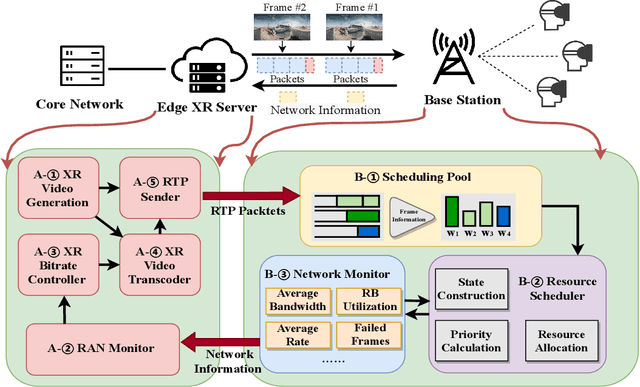
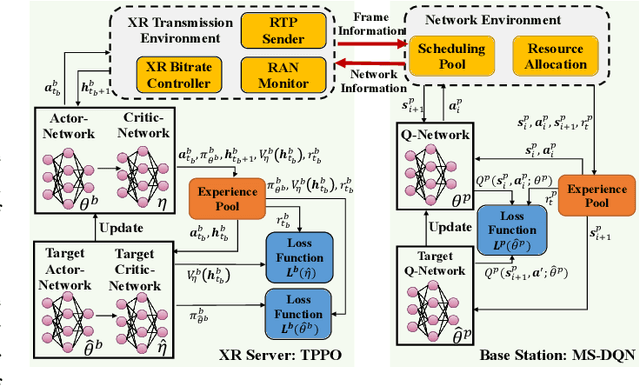
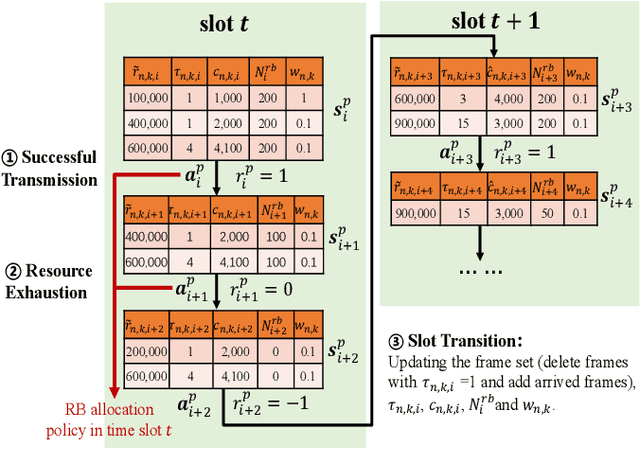
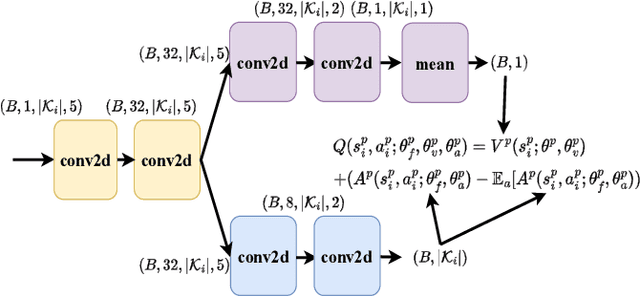
Abstract:Extended reality (XR) is one of the most important applications of beyond 5G and 6G networks. Real-time XR video transmission presents challenges in terms of data rate and delay. In particular, the frame-by-frame transmission mode of XR video makes real-time XR video very sensitive to dynamic network environments. To improve the users' quality of experience (QoE), we design a cross-layer transmission framework for real-time XR video. The proposed framework allows the simple information exchange between the base station (BS) and the XR server, which assists in adaptive bitrate and wireless resource scheduling. We utilize the cross-layer information to formulate the problem of maximizing user QoE by finding the optimal scheduling and bitrate adjustment strategies. To address the issue of mismatched time scales between two strategies, we decouple the original problem and solve them individually using a multi-agent-based approach. Specifically, we propose the multi-step Deep Q-network (MS-DQN) algorithm to obtain a frame-priority-based wireless resource scheduling strategy and then propose the Transformer-based Proximal Policy Optimization (TPPO) algorithm for video bitrate adaptation. The experimental results show that the TPPO+MS-DQN algorithm proposed in this study can improve the QoE by 3.6% to 37.8%. More specifically, the proposed MS-DQN algorithm enhances the transmission quality by 49.9%-80.2%.
Real-time Extended Reality Video Transmission Optimization Based on Frame-priority Scheduling
Feb 08, 2024


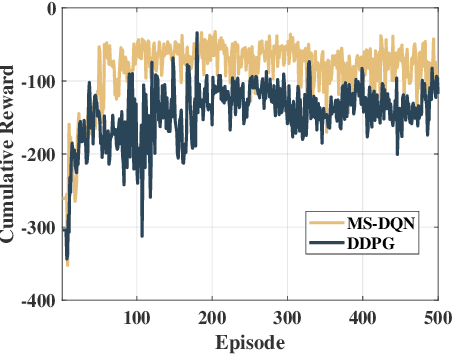
Abstract:Extended reality (XR) is one of the most important applications of 5G. For real-time XR video transmission in 5G networks, a low latency and high data rate are required. In this paper, we propose a resource allocation scheme based on frame-priority scheduling to meet these requirements. The optimization problem is modelled as a frame-priority-based radio resource scheduling problem to improve transmission quality. We propose a scheduling framework based on multi-step Deep Q-network (MS-DQN) and design a neural network model based on convolutional neural network (CNN). Simulation results show that the scheduling framework based on frame-priority and MS-DQN can improve transmission quality by 49.9%-80.2%.
A Hard and Soft Hybrid Slicing Framework for Service Level Agreement Guarantee via Deep Reinforcement Learning
Mar 06, 2022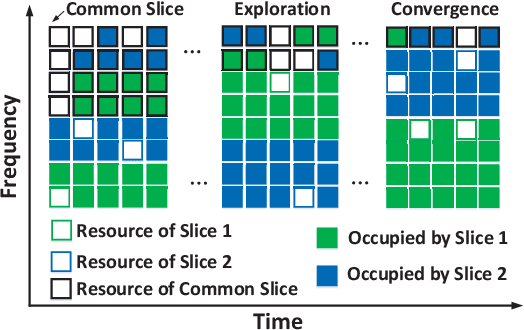
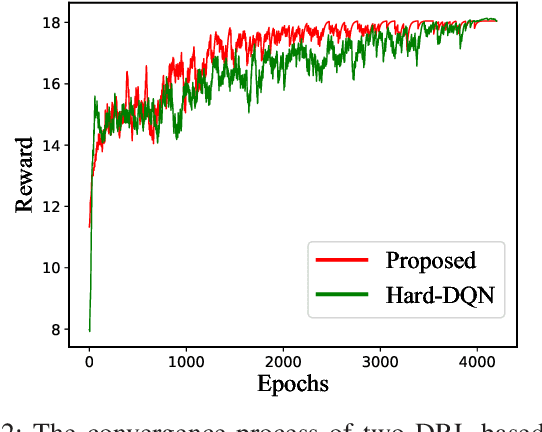
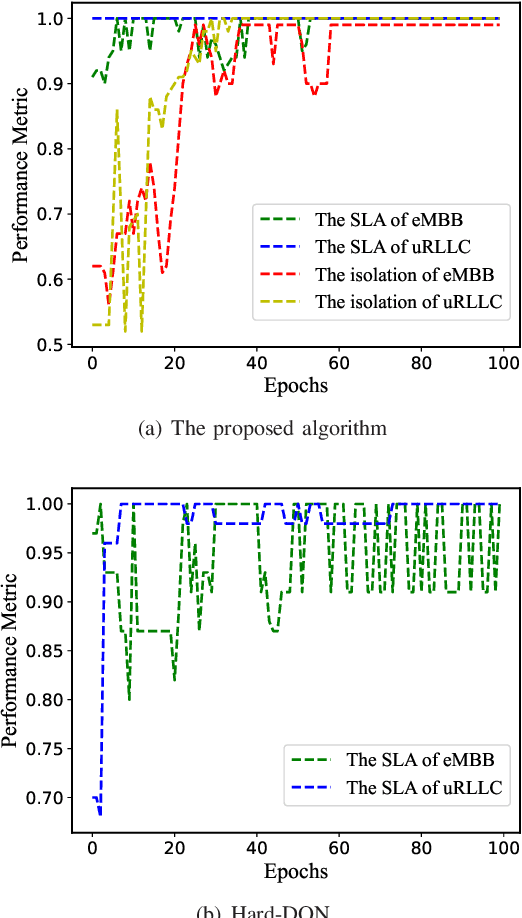
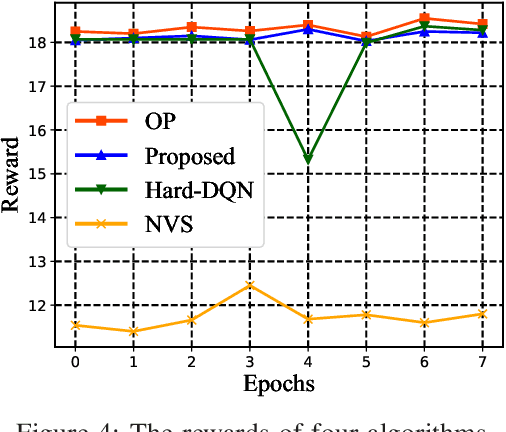
Abstract:Network slicing is a critical driver for guaranteeing the diverse service level agreements (SLA) in 5G and future networks. Recently, deep reinforcement learning (DRL) has been widely utilized for resource allocation in network slicing. However, existing related works do not consider the performance loss associated with the initial exploration phase of DRL. This paper proposes a new performance-guaranteed slicing strategy with a soft and hard hybrid slicing setting. Mainly, a common slice setting is applied to guarantee slices' SLA when training the neural network. Moreover, the resource of the common slice tends to precisely redistribute to slices with the training of DRL until it converges. Furthermore, experiment results confirm the effectiveness of our proposed slicing framework: the slices' SLA of the training phase can be guaranteed, and the proposed algorithm can achieve the near-optimal performance in terms of the SLA satisfaction ratio, isolation degree and spectrum maximization after convergence.
A Novel GCN based Indoor Localization System with Multiple Access Points
Apr 21, 2021



Abstract:With the rapid development of indoor location-based services (LBSs), the demand for accurate localization keeps growing as well. To meet this demand, we propose an indoor localization algorithm based on graph convolutional network (GCN). We first model access points (APs) and the relationships between them as a graph, and utilize received signal strength indication (RSSI) to make up fingerprints. Then the graph and the fingerprint will be put into GCN for feature extraction, and get classification by multilayer perceptron (MLP).In the end, experiments are performed under a 2D scenario and 3D scenario with floor prediction. In the 2D scenario, the mean distance error of GCN-based method is 11m, which improves by 7m and 13m compare with DNN-based and CNN-based schemes respectively. In the 3D scenario, the accuracy of predicting buildings and floors are up to 99.73% and 93.43% respectively. Moreover, in the case of predicting floors and buildings correctly, the mean distance error is 13m, which outperforms DNN-based and CNN-based schemes, whose mean distance errors are 34m and 26m respectively.
 Add to Chrome
Add to Chrome Add to Firefox
Add to Firefox Add to Edge
Add to Edge